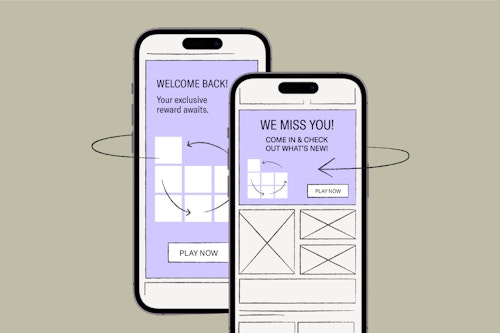7 best practices for app retargeting
September 18, 2023

Downloads and installs are vital for growing an app business. But after acquiring users, mobile marketers must start communicating with them right away to maintain engagement and drive long-term revenue.
Globally, 74% of today’s app users uninstall an app or become inactive the day after the install, which means mobile marketers need to think about ways to increase retention rates. At Remerge, we’ve worked with thousands of brands across multiple industries to implement retargeting campaigns that continue to bring users back to their apps.
In this article, we share some app retargeting tips and tricks to help you optimize your mobile marketing campaigns. We've also included episodes of our Apptivate podcast, where you can hear directly from the experts.
1. Understand the value of bringing churned users back to your app
Establishing the value of re-engaging a churned user increases the efficiency of your retargeting campaigns, but it also brings more value back to your overall business. Imagine a user installs your app but fails to complete the first desired in-app action, such as a registration. You've just missed a glorious opportunity to learn more about a potentially loyal customer and the chance to start making a real connection with them. For example, do you ask for an email address as part of your registration or sign up event? If so (and in compliance with data privacy measures), you can link this information to your internal CRM data and start building a relationship with the user across multiple channels.
2. Use deep links
Make it as easy as possible for users to return to the heart of your app. Deep links - links that send users directly to a specific in-app location, instead of the app marketplace - are important for improving your app’s user experience and increasing conversions from churned users. A gaming app, for example, can show an ad to encourage a user stuck on a certain level to try playing it again. A deep link within the ad will take that user to the point in the app where they dropped off.
3. Use a 3rd party mobile tracking and attribution provider
Mobile measurement partners (MMPs) specialize in measuring activities that occur within and leading up to the app. They will take care of independently tracking all of your retargeting campaign data, as well as sharing your app’s audience data with your retargeting partner in real-time. You can then easily share your relevant audience data with your retargeting partner in order to build your desired segments.
4. Segment your users
Utilize all available user data and build relevant segments. This will enable you to send powerful and personalized messages to your users, which will result in better conversion rates. Furthermore, it will enable you to compare performance across different segments. By concentrating on users who have reached a particular stage within your app, e.g., reached a certain level or made a first product search, you can increase your conversion to purchase rates.
5. Automate every step
The app retargeting process can be complex and manual (e.g., consider exporting, segmenting and uploading your entire audience data for multiple apps on a daily basis). Choose a partner that streamlines everything by replacing all manual processes. Aside from easy and secure access to data, this also includes dynamic audience segmentation, which spares you segmenting users manually and - more importantly - excludes your users in real time, such as those who have already converted in other channels (i.e., push notification, email marketing or even organic).
6. Customize your creatives, segments and landing pages
Creating great ads and in-app landing pages for different segments takes time and skill. Nevertheless, this is an investment in the long-term. Make sure to go with a partner that offers you this service, as well as the relevant reporting and testing capabilities, so you can continue to apply what you learn and optimize towards the best possible performance.
7. A/B test. Learn. Optimize. Repeat.
The most successful campaigns constantly evolve as deeper insights surface from performance data. When starting out, you may want to test simple segments throughout the entire conversion funnel to better understand your users’ behavior. From there, you can refine your approach to segmentation, creatives and messaging as your understanding of user behavior becomes more sophisticated. Get as much transparency as possible about your users to make sure you hit the sweet spots in your app.
Learn more about how app retargeting works
Our team at Remerge has created comprehensive guide to in-app retargeting, covering everything from how to launch your first programmatic retargeting campaign and setting the right KPIs to building creatives and measuring ad performance. You can access the guide for free.
Join our newsletter





